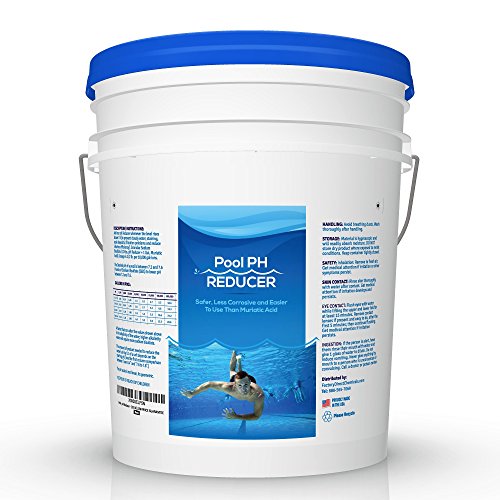So, you just tested your saltwater pool’s water and noticed that the pH was too high. In this article, we’ll go over all aspects of having a high pH in your saltwater pool, including the causes, what to do to resolve the issue, and ways to prevent further occurrences.
To quickly reduce the pH level in a saltwater pool, add 35-60 fl oz of muriatic acid per 10,000 gals of water to reduce alkalinity by 10 ppm. Or add approx 3 oz of sodium bisulfate per 10,000 gals of water to reduce pH by 0.1. The dosages do vary, as the pH scale is not linear. The closer the pH is to the target pH level of 7.4-7.6, the more acid you’ll need.
In order to understand how these different methods reduce pH, as well as ways to prevent such events from happening in the future, we’ll first have to understand why high pH levels can occur especially in saltwater pools, so let’s dive into that now (no pun intended).
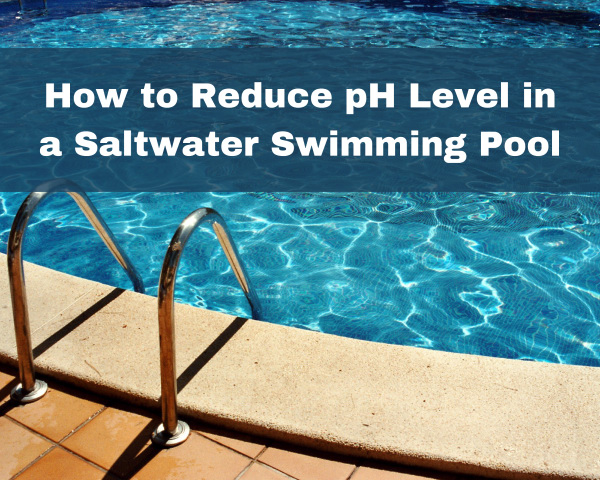
Article Contents
How Does pH Differ in a Saltwater Pool vs. a Chlorine Pool?
When it comes to the pH requirements of salt water and chlorine pools, they are the same.
Both pools need to have a pH level of 7.4-7.6. This level is ideal for several reasons. This pH level is good for both swimmers and the health of the pool. More on this later.
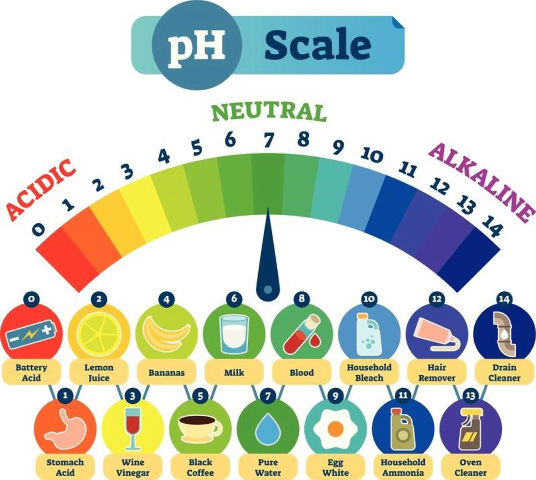
The way in which the pH differs in a saltwater pool though is saltwater pools are prone to constantly rising pH levels. This is a byproduct of the method used to produce chlorine. It’s something that needs to be lowered regularly.
Further Reading: Saltwater Vs Chlorine Pool | Are Salt Pools Better?
What Causes High pH Levels in a Saltwater Pool?
Though both saltwater pools and chlorine pools use chlorine in order to sanitize the water, the method in which saltwater pools get their chlorine tends to cause constantly rising pH, an issue that is absent in chlorine pools.
Specifically, the pH level in a saltwater pool is more prone to rise. Thus, it will require to be monitored more closely.
The reason behind this is that the process in which saltwater pools generate chlorine creates byproducts with very high pH. In order to create chlorine from salt, saltwater pools use saltwater chlorine generators (SWG) to convert water and salt (sodium chloride) into chlorine and sodium hydroxide. The process is called electrolysis.
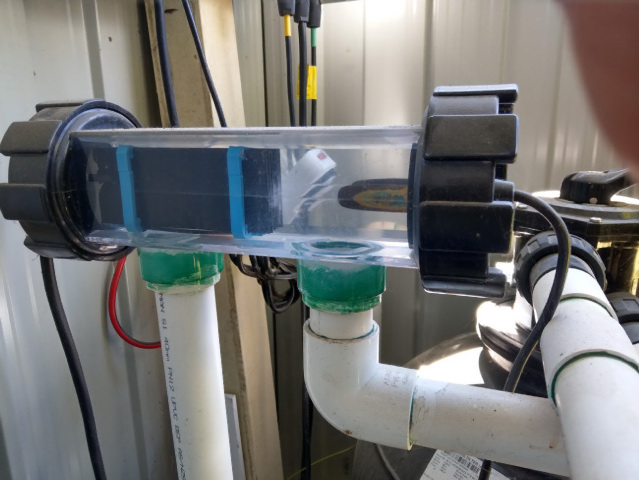
A regular chlorine pool, on the other hand, doesn’t use this process, thus the pH is much more manageable.
Chlorine is what we want, but the conversion process also creates the byproduct of sodium hydroxide (the sodium from salt combines with hydrogen and oxygen from water).
This byproduct, Sodium hydroxide, has a high pH, about 13+. This is why the pH level in your saltwater pool will tend to rise.
Another less likely cause is that the total alkalinity level in your pool is too high. As alkalinity is used as a buffer to help keep the pH in the water stable, a higher than normal total alkalinity level can pull the pH up with it.
Related Reading: What is Total Alkalinity in Pools | pH vs Alkalinity
Effects of Having High pH Levels in Saltwater Pools
Having high pH levels in your saltwater pool can be detrimental, with it resulting in a variety of issues. Not only can the high pH levels be harmful to your health, but they can also damage the pool surface, tiles, and even the salt generator itself.
Here are some of the effects of high pH in a saltwater pool:
- Skin irritations
- Eye irritations and discomfort
- Scale on pool equipment & pool tiles
- Saltwater cell scale (reduced efficiency)
- Cloudy water
- Reduced chlorine effectiveness
Having high pH levels can be quite irritating, literally. It’s relatively easy to know if the pH levels in your pool are too high because it can cause a physical reaction in the form of eye and skin irritation.
You can also see it, as it can cause the water to cloud up and can result in damage to your pool equipment. When the pH in your saltwater pool is too high, it can become scale forming, meaning it can cause you to have to clean the cells in the salt generator more frequently and can increase the risk of staining or scaling of your pool surfaces and tiles.
Finally, having either high pH or total alkalinity can significantly reduce the effectiveness of chlorine. This means you’ll need more chlorine to do the same job. And because chlorine is used to keep the pool sanitized, once it’s compromised, you’re much more likely to get algae.
Related Reading: How to Raise Alkalinity In Pool Without Raising pH
Best Chemicals to Reduce Saltwater Pool pH
The two most common chemicals to reduce pH in a saltwater pool are:
- Muriatic acid
- Sodium bisulfate
Muriatic Acid
Muriatic acid is a very common form of acid to reduce the pH level of saltwater pools. It comes in a liquid form. It’s cheaper to use than sodium bisulfate.
Muriatic acid is not suitable for vinyl liner pools.
Sodium Bisulfate
This acid comes in a powder form and is sometimes called ”dry acid”. It is commonly sold in pool stores with names such as “pH Down”, “pH Reducer”, and “Alkalinity Reducer” and comes in a bucket or container.
You’ll need to use more of it compared to muriatic acid which makes it more expensive. But it is safer to handle.
Here are some well-known products currently on the market that use these chemicals to lower pH:
Products Containing Muriatic Acid:
| Name | Cost | Pros | Cons |
| Acid Blue Muriatic Acid – Swimming Pool pH Reducer Balancer | Buffered, Low -Fume – Case | $50 – $100 | Brightens concrete and masonry surfaces Additional vapor reduction technology reduces up to 90% of harmful vapors compared to typical muriatic acid | Muriatic acid concentration is lower than other products, becoming less effective for larger pools |
| Acid Magic, Muriatic Replacement Acid | $50 – $100 | 90% fewer fumes Does not burn skin | Slightly on the pricier side |
Acid Blue Muriatic Acid – Swimming Pool pH Reducer Balancer | Buffered, Low -Fume – Case
Acid Magic, Muriatic Replacement Acid
Further Reading: Can I Add Muriatic Acid All at Once? | How to Safely Add
Products Containing Sodium Bisulfate
| Name | Cost | Pros | Cons |
| Pool pH Reducer | Pool & Hot Tub Spa pH Reducer | pH Down | Sodium Bisulfate | $50 – $100 | No discoloration on pool lining Easy to open lid that prevents spilling | Might cause the water to cloud up on rare occasions Not as effective as some muriatic acid products |
| In The Swim Pool Granular pH Reducer | Under $50 | Works well on all surfaces | No labeling that shows the percentage of chemical Can be difficult to manage without a scoop |
Pool pH Reducer | Pool & Hot Tub Spa pH Reducer | pH Down | Sodium Bisulfate
In The Swim Pool Granular pH Reducer
How to Reduce pH Level in a Saltwater Pool with Muriatic Acid
Here’s what you’ll need:
- Pool-grade muriatic acid
- Safety goggles
- Acid-resistant gloves
- Chemical-resistant apron
- Plastic 5-gallon bucket
- Wooden/plastic stirrer
Here’s what to do:
1. Test the Alkalinity and pH
First off, test the pH and total alkalinity of your pool water by either using test strips or digital test kits.
Because you’ll have to lower your pool’s alkalinity little by little, you should retest your water each time after adding at most ½ gallon of muriatic acid
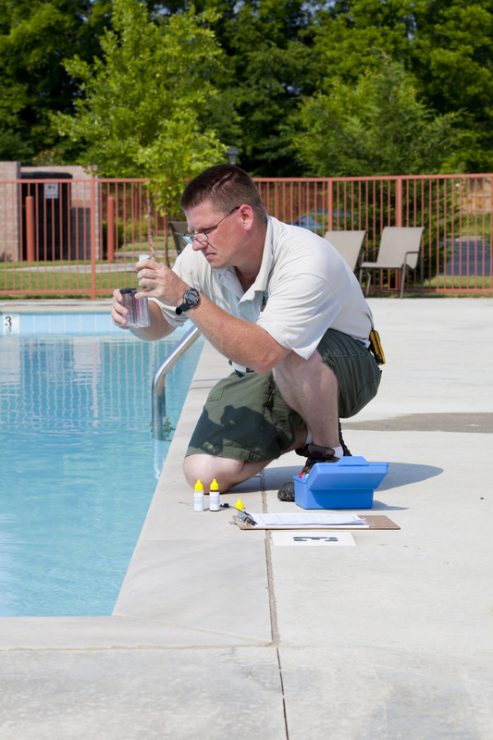
2. Turn on the Pump
Let your pool pump circulate so that the acid will mix with the water when its added. Make sure to turn off any aerators or fountains as the excess air can raise your pH.
3. Calculate the Dosage
Calculate the volume of your pool and use it to determine the amount of muriatic acid to add.
Try to bring your pH down to just below the optimal level, which should bring the alkalinity down to normal. Typically, 35-60 ounces of acid will be enough to lower the alkalinity in a 10,000-gallon pool by 10 ppm.
4. Mix the Muriatic Acid
With your safety gear on, add water, then muriatic acid, to an acid-resistant bucket (the typical ratio is 10:1, but follow the manufacturer’s instructions) and stir with a plastic or wooden stir stick.
Tip: Only add a ¼ to 1/3 of the calculated dosage at a time. Wait then retest. You’re better to underdo it rather than overshoot.
Warning: Muriatic acid is dangerous. Don’t spill it on your clothes or on the pool surroundings. Wash skin with water straight away if it splashes. And wash any pool surfaces with water immediately, it will etch the surfaces if you don’t.
5. Pour the Acid Slowly Around the Pool
Slowly and carefully, walk around the pool pouring in the acid to distribute it throughout.
Make sure to rinse the bucket after every use and NEVER use the same bucket for any other pool chemical. It could have a dangerous reaction.
After you’ve added the acid to the water, leave the pump on for at least 30 minutes in order to let the acid mix in and prevent it from damaging your pool surfaces.
6. Retest your water
Wait 3-6 hours (enough time for the water to turn over and mix the acid well). If you notice that the alkalinity hasn’t gone down far enough, you can add another dose of the acid.
Remember to always add it in doses of ½ gallon or less. Taking multiple doses to lower the alkalinity is normal.
If you noticed that, while the alkalinity is normal, the pH has dipped too low, you can aerate your pool by turning on jets or splashing the water to bring only the pH up. No, I’m not kidding.
If it’s still too low, you might have to consider using a chemical pH increaser; just keep in mind that it can raise the alkalinity too, so use it sparingly.
How to Reduce pH Level in a Saltwater Pool with Sodium Bisulfate
Here’s what you’ll need:
- Pool-grade sodium bisulfate
- 5-gallon bucket
- Wooden/plastic stirrer
Here’s what to do:
1. Test the Alkalinity and pH
As with the previous method, you’ll need to test your pool’s chemistry level first with either a liquid or strip pool testing kit in order to make sure the pH needs to be reduced.
2. Turn on the Pump
You’ll need the pump running to circulate and mix the sodium bisulfate.
3. Calculate the Dosage
Once you’ve made sure sodium bisulfate is required, read the instructions on the product and use about ¼ to 1/3 of what the instructions call for, since you can always add more later.
4. Mix the Sodium Bisulfate Acid
Based on the instructions, determine if the sodium bisulfate requires dilution. If so, then use a wooden/plastic stirrer and a 5-gallon bucket to dilute it to the appropriate ratio.
5. Add the Sodium Bisulfate Around the Pool Edges
Add the sodium bisulfate solution to the pool either near the return jets (for inground pools) or along the pool wall (for above-ground pools).
6. Retest your Water
Allow the product to mix and do its job for at least the next 6 hours. Don’t return to the pool until the water composition is back to normal.
Retest the water after 6 hours to confirm if more solution is needed. Both pH and alkalinity should be at optimal levels.
Ways to Prevent pH from Rising in a Saltwater Pool
Now that you’re familiar with the ways to lower your pH, let’s use our knowledge of why the pH rose in the first place in order to come up with some ways to prevent the issue from reoccurring.
Controlling pH via Monitoring Chlorine Levels
Excess chlorine production is one of the main factors to having a high pH level in a saltwater pool. Thus, you’ll want to make sure the chlorine production levels in your saltwater pool are under control, which can be done using the chlorine generator settings.
Turn down the percentage settings in your saltwater chlorine generator in order to slow down chlorine production. But you still want to maintain chlorine levels of 1-5 ppm.
Overall, make sure your chlorine stabilizer levels are kept within the recommended range of 30-50 ppm for a saltwater pool.
Controlling pH via Monitoring Total Alkalinity (TA) Levels
Test your Total Alkalinity levels regularly. pH usually follows alkalinity. In other words, if the alkalinity goes up, so will the pH.
In this case, you’ll want to first lower your TA level down to about 70-80 ppm using muriatic acid (which will reduce pH as well to around 7). Next, you’ll want to add borate (otherwise known as Borax) to raise the pH back to around 7.2 to 7.4. Borax is a very stable pH increaser and thus, the pH should remain stable unless you add more of the pH increaser.
Common Saltwater Pool pH Questions
Now that we’ve gone over the main ideas of the article, let’s take a look at some FAQs that might prove helpful along the way.
Muriatic Acid vs. Sodium Bisulfate: Which is Better?
Let’s look at the pros and cons of each of these methods to help you make your decision:
| Pros | Cons | |
| Muriatic Acid | Can be used for more than just the pool More likely to be found already in your toolbox Works faster at stabilizing pH and alkalinity levelsCheaper | Can be quite dangerous to handle Requires you to have proper safety equipment before handling (i.e. gloves, eyewear, mask, etc.)Always comes in a liquid form, so it’s easy to get spilled/splashed on by accident |
| Sodium Bisulfate | Safer and much more user friendly Typically comes in a solid form, so no risk of splashback | Takes longer to stabilize pH and alkalinity More expensive |
As you can see, each chemical has its pros and cons. In order to determine which one is right for you, it’s up to you to decide what your priorities are and which of these are more adept at meeting them.
Can You Use CO2 to Reduce Saltwater Pool pH?
As opposed to the common reduction methods, using CO2 is a relatively newer method that uses carbon dioxide to form hydrogen ions, which then reduce pH. The exact process is a bit more complex, so we won’t go over them here today but just know that, compared to using chemicals, using CO2 can be more cost-effective and accurate in controlling pH.
On the other hand, the setup and installation process is a bit more complex, so you’ll probably need the help of a professional.
Final Thoughts
We’ve gone over a lot of material today, but at the end of the day, remember that having a higher than normal pH in a saltwater pool is quite common. There are several ways, which are relatively simple, to decrease your pool’s pH level. As long as you’re keeping proper management of your pool chemicals, it should be simple to maintain.
Related Reading:
How to Lower Hot Tub pH Naturally (Using Vinegar)
Does Adding Chlorine Change Pool pH Level?
How to Lower pH in Hot Tub (pH is Too High)



